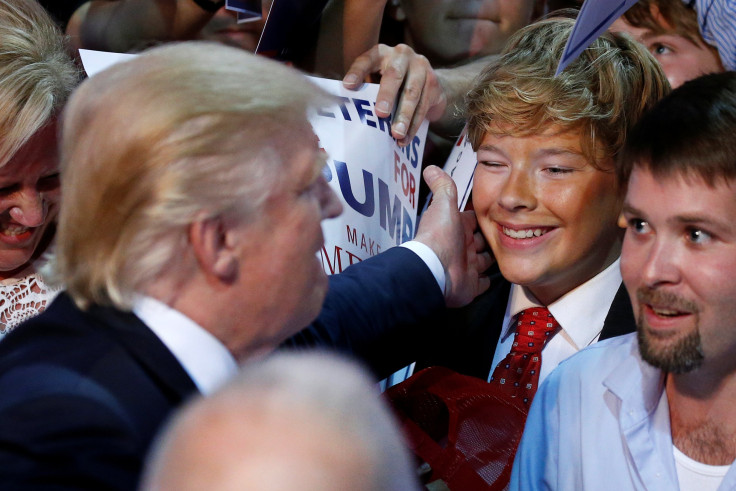Donald Trump Campaign Promises: 10 Policies That Will Most Affect Millennials

President Donald Trump was sworn into office Friday after winning an election last year in which half of the millennial population, described as those between the ages of 18-29, did not vote.
The age group has one of the poorest turnout records for elections, which was as low as 41 percent in the contentious 2000 presidential election and modestly rose to 52 percent in 2008.
Nevertheless, Trump's proposed presidential policies were likely to have a significant impact on young adults and their futures. International Business Times gathered a list of 25 proposed policies and campaign promises, taken from various press statements, speeches and tweets by the president-elect, which may have the greatest impact on millennials.
1. Trump has pledged to allocate $20 billion in additional federal funding toward school choice, assisting low-income students toward enrolling in more expensive private and charter schools. Critics have become concerned about how this money could negatively affect funding for public schools.
2. Trump proposed simplifying the current process by which college students repay their loans. There were five plans through which students can repay their debt and the president-elect has considered consolidating the system into one, with payment capped at a higher percentage of income. However, total forgiveness would be granted after 15 years of payments, five to 10 years sooner than any current scheme. Trump also said he would make college more affordable.
3. The president-elect has continually discussed the idea of establishing a registry of all Muslims dwelling in the country, drawing criticism from civil rights groups and religious organizations. Muslim-Americans were much younger than the general population, with 36 percent falling in the 18-29 age group, according to a 2011 study by Pew Research Center.
4. Trump has also set his sights on undocumented immigrants in the U.S. The President-elect vowed to strictly enforce immigration laws, even tripling the number of agents responsible for catching those residing illegally in the country. Around 4.4 million unauthorized individuals residing in the U.S. were under 30, according to a 2012 Pew Research Center study. The age group accounts for over a third of the 11.4 million in total calculated for that period.
5. Republicans have already begun taking steps toward repealing the Affordable Care Act, otherwise known as Obamacare. Trump was a vocal critic of his predecessor's attempt to provide coverage for all U.S. citizens, calling it costly and disorganized. Millennials' failure to sign up for Obamacare in adequate numbers has been credited with helping to defeat Obama's historic legislature, with only 30 percent of the key demographic having enrolled. Under Obamacare, individuals can stay on their parents' healthcare plan until the age of 26. It was not immediately clear what Trump's alternative would offer.
6. The U.S. is the only developed nation lacking in paid family leave. Trump has said he would mandate companies provide new mothers with a salaried six weeks off. The average age at which women give birth to their first child was just over 26, according to a 2014 report by the National Center for Health Statistics.
7. Trump has said he would support expanding assistance to the Department of Veterans Affairs, the federal agency tasked with providing benefits to returning soldiers. An estimated 77.1 percent of the U.S. military was between the ages of 18 and 30, according to a 2014 military demographics report. The department, which was the center of a 2014 scandal, has been accused of corruption and criticized for ineffectiveness. Trump said he would clean house as well as increase the current force by 60,000, bringing the total number of troops to 540,000.
8. Federal programs deemed unnecessary have been a primary target for Trump. Specifically, federal assistance programs such as food stamps and welfare could be scaled back by a reduction in funding. Individuals between the ages of 18 and 29 made up about 30 percent of the total population receiving low-income assistance, according to a 2012 Pew Research Center study. The same group made up 12 percent of those benefitting from federal assistance programs directed toward older individuals.
9. Part of Trump's iconic "Make America Great Again" campaign slogan was bringing jobs back to the U.S. The President-elect has said his economic plans would create 25 million jobs over the next decade and grow the economy by 3.5 percent a year. The effective unemployment rate for those between the ages of 18 and 29 - taking into account those who have stopped looking for work - was 12.8 percent, according to libertarian advocacy group Generation Opportunity, which cites government figures. The figure was above the national average of 9.3 percent for all age groups around the sound time.
10. Unlike many of his fellow Republicans, Trump has vowed to preserve social security. The federal insurance program will no longer be able to make full payments by 2034 without government intervention, according to current estimates and will require government intervention to maintain. Only 6 percent of millennials said they expected to receive full benefits when they reached 67 years old and 51 percent figured the entire system would be dismantled, according to a 2014 survey by Pew Research Center. Trump has not yet indicated how he would move to save the ailing system.
© Copyright IBTimes 2024. All rights reserved.






















